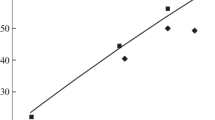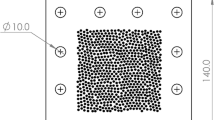Abstract
Results are presented from a study of the hypervelocity impact of steel and glass particles against barriers made of glass-textolite. Collision velocities ranged up to 11 km/sec. Several features of the process are discussed in relation to impact against elastoplastic materials. Several empirical relations established earlier for metals reliably describe the results for the composite.
Similar content being viewed by others
References
B. G. Cour-Palais, “Hypervelocity impact in metals, glass, and composites,” Int. J. Impact Eng.,5, No. 1-4, 221–237 (1987).
L. A. Merzhievskii and V. M. Titov, Fiz. Goreniya Vzyrva,23, No. 5, 92–108 (1987).
C. H. Yew and R. B. Kendrick, “A study of damage in composite panels produced by hypervelocity impact,” Int. J. Impact Eng.,5, No. 1-4, 729–738 (1987).
E. L. Christiansen, “Investigation of hypervelocity impact damage to space station truss tubes,” Int. J. Impact Eng.,10, No. 1-4, 125–133 (1990).
W. P. Schonberg, “Hypervelocity impact response of spaced composite material structures,” Ibid., 509–523 (1990).
N. N. Gorshkov, A. V. Plastinin, and V. V. Sil'vestrov, “Through piercing of glass-textolite in hypervelocity impact,” Fiz. Goreniya Vzryva,28, No. 4, 115–120 (1992).
L. A. Merzhievskii, V. M. Titov, Yu. I. Fadeenko, and G. A. Shvetsov, “Hypervelocity propulsion of rigid bodies,” Fiz. Goreniya Vzryva,23, No. 5, 77–82 (1987).
R. Eichelberger and J. Kainike, “Hypervelocity impact,” in: Physics of Fast-Acting Processes [Russian translation], Vol. 2, Mir, Moscow (1967), pp. 204–246.
A. E. Williams and M. A. Persechino, “The effect of projectile properties on target cratering,” Int. J. Impact Eng.,5, No. 1-4, 709–728 (1987).
A. V. Plastinin, V. V. Sil'vestrov, and N. N. Gorshkov, “Dynamic compression of unidirectional glass-plastic,” Din. Sploshnoi Sredy,93, 94, 111–118 (1989).
J. Gehring, “Hypervelocity impact from an engineering viewpoint,” in: Hypervelocity Impact Phenomena [Russian translation], Mir, Moscow (1970), pp. 468–516
V. I. Titov and Yu. I. Fadeenko, “Through piercing in meteorite impact,” Kosm. Issled.,10, No. 4, 589–595 (1972).
A. P. Anikieva, L. A. Merzhievski, and V. M. Titov, “Piercing of barriers in the impact of particles of glass simulating stony meteorites,” Zh. Prikl. Mekh. Tekh. Fiz., No. 3, 131–136 (1977).
Additional information
M. A. Lavrent'ev Institute of Fluid Dynamics, Siberian Branch of the Russian Academy of Sciences, 630090 Novosibirsk. Translated from Fizika Goreniya i Vzryva, Vol. 31, No. 3, pp. 92–103, May–June, 1995.
Rights and permissions
About this article
Cite this article
Sil'verstrov, V.V., Plastinin, A.V. & Gorshkov, N.N. Hypervelocity impact against glass-textolite. Combust Explos Shock Waves 31, 352–361 (1995). https://doi.org/10.1007/BF00742682
Received:
Revised:
Issue Date:
DOI: https://doi.org/10.1007/BF00742682




